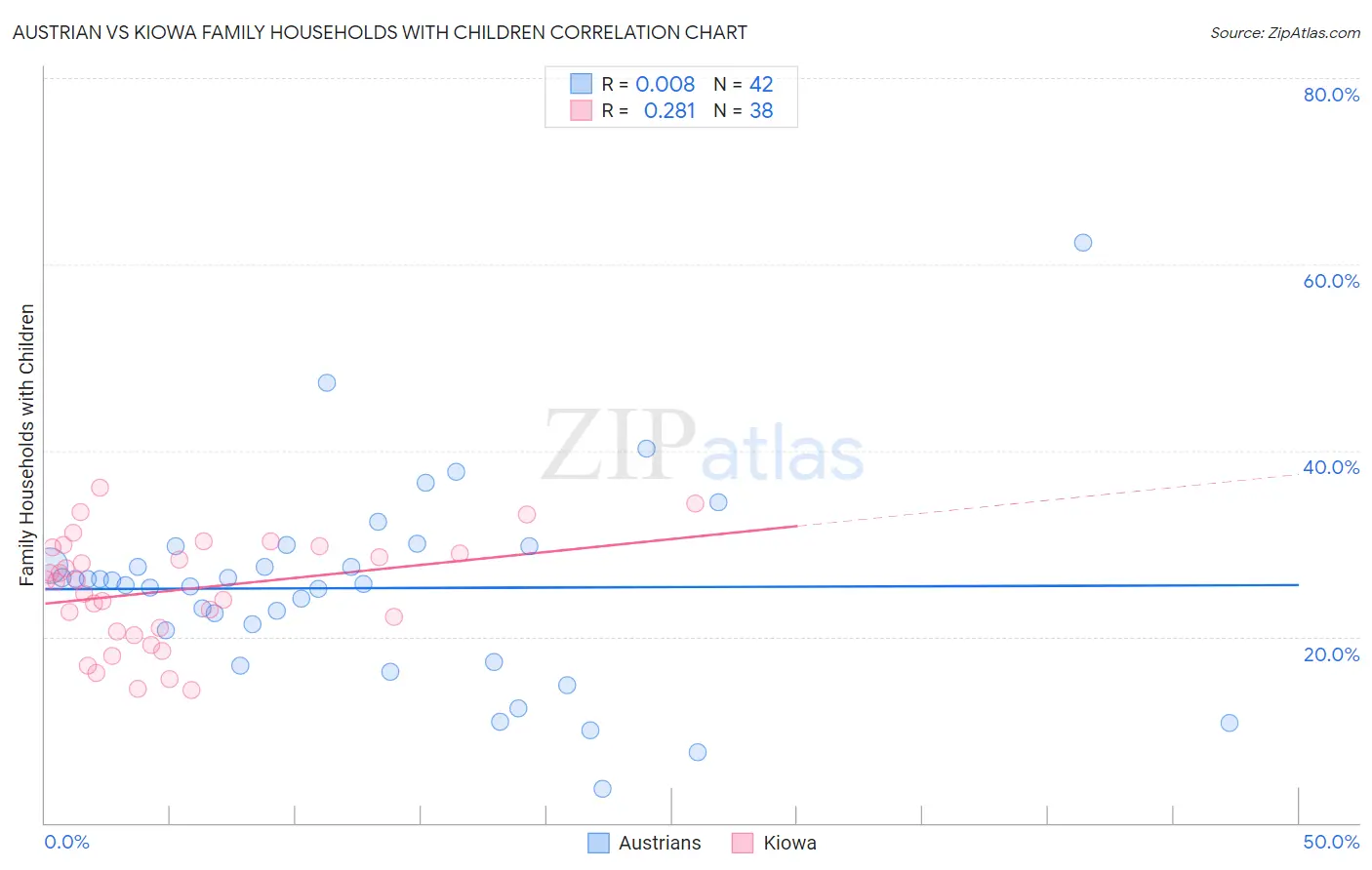Austrian vs Kiowa Family Households with Children
COMPARE
Austrian
Kiowa
Family Households with Children
Family Households with Children Comparison
Austrians
Kiowa
27.1%
FAMILY HOUSEHOLDS WITH CHILDREN
9.9/ 100
METRIC RATING
220th/ 347
METRIC RANK
27.3%
FAMILY HOUSEHOLDS WITH CHILDREN
22.2/ 100
METRIC RATING
203rd/ 347
METRIC RANK
Austrian vs Kiowa Family Households with Children Correlation Chart
The statistical analysis conducted on geographies consisting of 451,563,226 people shows no correlation between the proportion of Austrians and percentage of family households with children in the United States with a correlation coefficient (R) of 0.008 and weighted average of 27.1%. Similarly, the statistical analysis conducted on geographies consisting of 56,098,282 people shows a weak positive correlation between the proportion of Kiowa and percentage of family households with children in the United States with a correlation coefficient (R) of 0.281 and weighted average of 27.3%, a difference of 0.53%.

Family Households with Children Correlation Summary
| Measurement | Austrian | Kiowa |
| Minimum | 3.6% | 14.3% |
| Maximum | 62.3% | 35.9% |
| Range | 58.6% | 21.7% |
| Mean | 25.2% | 25.0% |
| Median | 25.9% | 26.0% |
| Interquartile 25% (IQ1) | 20.7% | 20.5% |
| Interquartile 75% (IQ3) | 29.7% | 29.5% |
| Interquartile Range (IQR) | 9.1% | 9.0% |
| Standard Deviation (Sample) | 10.6% | 5.8% |
| Standard Deviation (Population) | 10.4% | 5.7% |
Demographics Similar to Austrians and Kiowa by Family Households with Children
In terms of family households with children, the demographic groups most similar to Austrians are New Zealander (27.1%, a difference of 0.020%), Immigrants from Japan (27.1%, a difference of 0.050%), Greek (27.1%, a difference of 0.090%), Cuban (27.1%, a difference of 0.13%), and U.S. Virgin Islander (27.1%, a difference of 0.13%). Similarly, the demographic groups most similar to Kiowa are American (27.3%, a difference of 0.020%), Immigrants from Sudan (27.3%, a difference of 0.020%), Immigrants from Haiti (27.2%, a difference of 0.070%), Immigrants from Micronesia (27.2%, a difference of 0.070%), and Haitian (27.2%, a difference of 0.080%).
| Demographics | Rating | Rank | Family Households with Children |
| Bhutanese | 25.1 /100 | #201 | Fair 27.3% |
| Americans | 22.8 /100 | #202 | Fair 27.3% |
| Kiowa | 22.2 /100 | #203 | Fair 27.3% |
| Immigrants | Sudan | 21.6 /100 | #204 | Fair 27.3% |
| Immigrants | Haiti | 20.3 /100 | #205 | Fair 27.2% |
| Immigrants | Micronesia | 20.2 /100 | #206 | Fair 27.2% |
| Haitians | 19.8 /100 | #207 | Poor 27.2% |
| Immigrants | Poland | 16.4 /100 | #208 | Poor 27.2% |
| Dutch West Indians | 15.8 /100 | #209 | Poor 27.2% |
| Immigrants | Ukraine | 14.4 /100 | #210 | Poor 27.2% |
| Welsh | 14.2 /100 | #211 | Poor 27.2% |
| Immigrants | Dominica | 13.9 /100 | #212 | Poor 27.2% |
| Okinawans | 13.7 /100 | #213 | Poor 27.2% |
| Africans | 13.0 /100 | #214 | Poor 27.2% |
| Northern Europeans | 12.8 /100 | #215 | Poor 27.2% |
| Cubans | 12.2 /100 | #216 | Poor 27.1% |
| U.S. Virgin Islanders | 12.1 /100 | #217 | Poor 27.1% |
| Greeks | 11.4 /100 | #218 | Poor 27.1% |
| Immigrants | Japan | 10.7 /100 | #219 | Poor 27.1% |
| Austrians | 9.9 /100 | #220 | Tragic 27.1% |
| New Zealanders | 9.6 /100 | #221 | Tragic 27.1% |